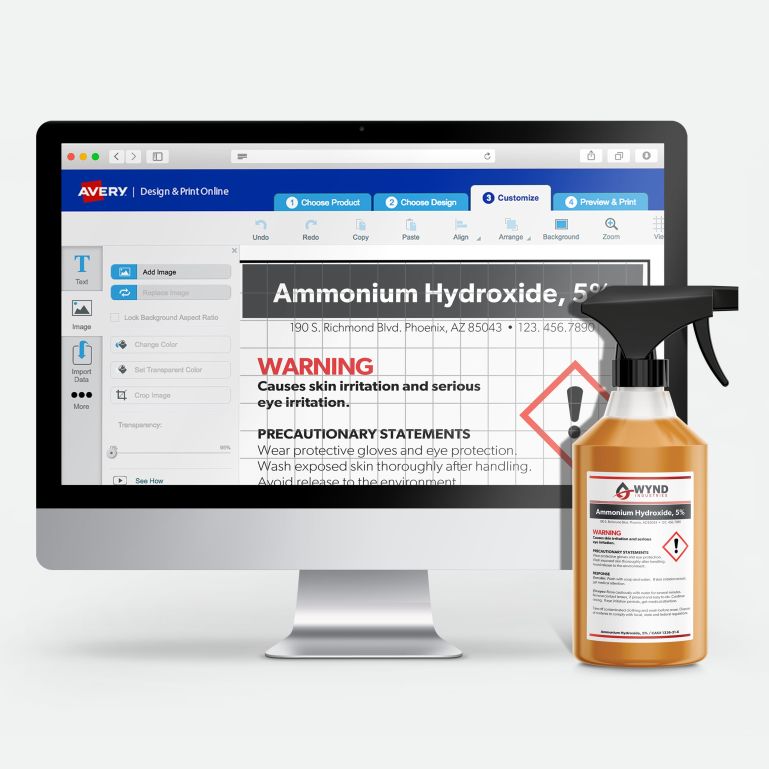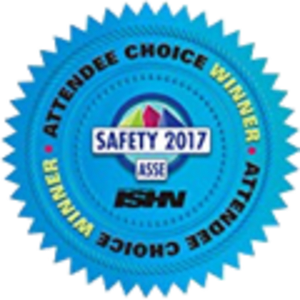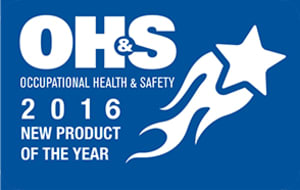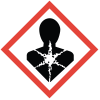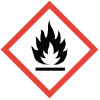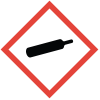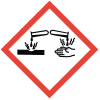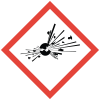In-Store GHS Label Packs
GHS Blank Labels by the Sheet
Custom Printed GHS Labels
Avery UltraDuty GHS Materials

Chemical Resistant:
Tested resistance to chemicals (e.g. Heptane, HCL 37%, pH3 buffer)

Abrasion Resistant:
Tested resistance to abrasion. Roll labels pass BS5609 Sec. 2 and 3 (click here for details and approved printers).

Temperature Resistant:
Adhesive Service Temp. -20˚F to 220˚F

Waterproof:
Passes BS5609 Section 2-90-day sea water submersion adhesion test

UV Resistant:
Up to 2 years UV fade resistance

Tear Resistant:
Durable synthetic label material resists tearing
Find Avery UltraDuty GHS Chemical Label templates in your favorite third-party label authoring program.

Velocity EHS/MSDSonline
The integration between VelocityEHS and Avery lets users of MSDSonline HQ and HQ RegXR chemical management accounts easily create GHS container labels. The functionality links MSDSonline HQ and HQ RegXR accounts to the free Avery GHS Wizard, allowing users to design, save and print GHS labels in a variety of sizes utilizing the data indexed for chemical products in their MSDSonline account.
Learn more
RightAnswer Knowledge Solutions
RightAnswer Knowledge Solutions offer chemical and regulatory information to help classify products, create labels or SDS and assist with GHS and EHS regulatory compliance. Subscribe to this comprehensive online system providing access to over 100 proprietary, government and EHS exclusive data sources with over 11 million documents covering more than 400,000 substances. All integrated and available through a single search. As an Avery Referred Customer, it’s only $14.99 a day.
Learn more
TEKLYNX International
TEKLYNX enterprise-level label designer CODESOFT supports a variety of industry-specific labeling regulations, including GHS. CODESOFT allows users to create complex database queries, integrate label printing and RFID technology, and create GHS-compliant labels with built-in HazCom pictograms. Download a free, 30-day trial of CODESOFT today to design your Avery UltraDuty GHS Labels.
Find answers to frequently asked questions about the Globally Harmonized System (GHS) and Avery UltraDuty GHS Chemical Labels. For more information, or if you need help, please visit our Support page.
1. What is GHS?
GHS stands for the Globally Harmonized System of Classification and Labeling of Chemicals. It was developed by the United Nations and its goal is to standardize and harmonize the classification and labeling of chemicals to give universally understood warnings to users. The three major areas of impact are:
- Hazard Classification: Definitions of hazard now include specific criteria for classifying health and physical hazards as well as classification of mixtures. It will result in more accurate safety data sheets.
- Labels: Chemical manufacturers, importers and distributors must use labels that include a harmonized signal word, pictograms and hazard statement for each hazard class and category. Precautionary statements must also be provided.
- Safety Data Sheets: Now have a specific 16-section standardized format.
2. When does GHS take effect?
The U.S. Occupational Safety and Health Administration (OSHA) adopted GHS in 2012. The timeline for implementation in the U.S. was as follows:
training begins
compliant labels
compliant labels
fully implemented
3. Who does it affect?
GHS affects chemical manufacturers, importers, distributors and any company that has hazardous chemicals in the workplace.
- Chemical manufacturers must re-classify their hazardous chemicals based on a common system of chemical classification defined by GHS. They must update their safety data sheets and also use GHS-compliant labels to identify their hazardous chemicals.
- Chemical importers/distributors must ensure the hazardous chemicals they sell have GHS-compliant safety data sheets and GHS-compliant labels.
- Employers with hazardous chemicals in the workplace must ensure that they have safety data sheets and labels for their exposed workers and that they are trained to handle the chemicals properly.
4. What is required on a GHS label?
The diagram below shows an example of the main elements of a GHS label.
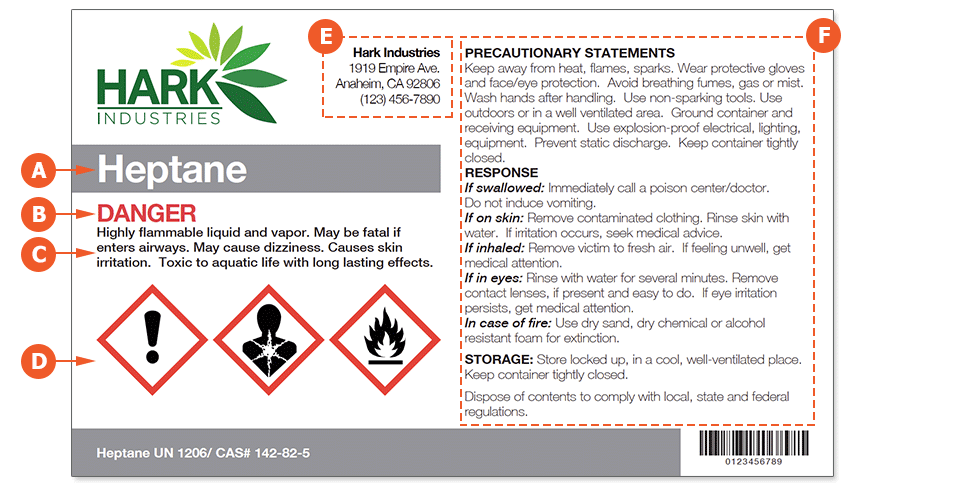
A. Product Name/Identifier
Should match product identifier on SDS
B. Signal Word
Indicates relative severity of hazard
C. Hazard Statement
Describes the nature of the hazard
D. Pictograms
Symbols to convey health, physical and environmental information
E. Supplier Identification
Name, address, telephone number of supplier
F. Precautionary Statements
Measures to minimize/prevent effects of hazard (includes first aid)
- Carcinogen
- Mutagenicity
- Reproductive Toxicity
- Respiratory Sensitizer
- Target Organ Toxicity
- Aspiration Toxicity
- Flammables
- Pyrophorics
- Self-Heating
- Emits Flammable Gas
- Self-Reactives
- Organic Peroxides
- Irritant (skin and eye)
- Skin Sensitizer
- Acute Toxicity (harmful)
- Narcotic Effects
- Respiratory Tract Irritant
- Hazardous to Ozone Layer
- Gases Under Pressure
- Skin Corrosion/burns
- Eye Damage
- Corrosive to Metals
- Explosives
- Self-Reactives
- Organic Peroxides
5. What is BS5609 Certification?
Companies with chemicals that will be exported via ocean freight must also comply with British Standard BS5609. This is a requirement for International Maritime Dangerous Goods (IMDG) certification
- BS5609 Section 2 requires that the blank label and adhesive can withstand a three-month salt water submersion test. It also includes artificial weathering tests (salt spray and sunlight). When a label is Section 2 certified, it means the blank label is BS5609 Section 2 compliant.
- BS5609 Section 3 tests the printed label for abrasion resistance and permanence of print. This includes artificial weathering (salt spray & sunlight), tape removal and abrasion resistance. This test is conducted on labels printed with specific printers.
Even if you are not shipping overseas, going with a BS5609 certified material ensures a durable label that will resist falling off or fading if exposed to water or sunlight.
Avery UltraDuty GHS Chemical Labels from WePrint are BS5609 Section 2 and 3 certified.
6. Does Avery have free software and templates for GHS?
Yes. Use our free Avery Design & Print GHS Wizard for a quick and easy way to create GHS labels. You can start with a blank or pre-designed template and then add GHS compliant information using a guided process. To get started on GHS Labels click here .
7. Does GHS affect current workplace hazard labeling systems?
Yes. If a chemical is supplied to the workplace with a GHS label, it must be maintained. If the chemical is transferred to a secondary container (i.e. tank or spray bottle) that remains in the workplace, then employers can choose to have it labeled it with the same information from the original GHS shipping label or safety data sheet. However, employers can also choose to use an alternative system such NFPA or HMIS. If using an alternative system, it is the responsibility of the employer to ensure that the information is consistent with GHS and that workers understand specific physical and health hazards.
If the chemical is transferred to a "portable" secondary container for use by only the person who transferred it during the same work shift, then it is considered "immediate use" and a label is not required.
8. Does GHS apply to small containers of chemicals?
Yes. Even if the hazardous chemical is in a small bottle, a manufacturer, importer or distributor must attach a GHS label to a hazardous chemical's immediate container if it is to be transported. It cannot be attached only to the outside packaging of a shipped chemical.
If a chemical manufacturer is able to show that it is not feasible to use a label (i.e. pull-out, fold-out label) or tags containing full GHS information, the shipped small chemical container at a minimum must contain the following:
- Product identifier
- Appropriate pictograms
- Manufacturer's name and phone number
- Signal word
- A statement indicating that the full label information for the chemical is on the outside package that is holding the smaller containers
Additionally, the outside packaging at a minimum must comply with the following:
- Outer label has all applicable GHS elements and it must be maintained (i.e. not torn, faded or destroyed)
- Information stating that the small container must be stored in the outer container which has the complete GHS label
- Ensure that outer packaging does not conflict with any other standard (i.e. outer packaging cannot be flammable if it contains a flammable chemical)
9. If I have a GHS label do I need a Department of Transportation (DOT) label?
Yes, DOT labels must still be on the external part of a shipped container and must meet the requirements set forth in 49 CFR 172, Subpart E. OSHA will allow both DOT and GHS pictograms for the same hazard on a label. While the DOT diamond label is required for all hazardous chemicals on the outside shipping container, chemicals in smaller containers inside the larger shipped container do not require the DOT diamond but do require the GHS pictograms.
10. Where can I get more detailed information on GHS?
Visit our Support page for additional information about GHS, regulatory requirements and proper labeling information.
For more information on The Globally Harmonized System of Classification and Labeling of Chemicals, visit the OSHA website at:
GHS Labels by Avery
Translate your chemical safety expertise into GHS-compliant labels to help protect your workers— because we understand that safety always comes first. Avery GHS labels are rigorously tested for performance and our simple straightforward online software helps fill in chemical info for you, saving time and reducing errors.
Our online GHS Wizard software helps you meet GHS label requirements with its autofill feature and OSHA-compliant pictograms. Simply enter the CAS number or chemical name and the GHS Wizard fills in the rest for you to review. Professionally designed GHS label templates allow you to quickly and easily add customized text, logos and images.
Chemical hazard labels constructed from durable UltraDuty™ synthetic film are backed with ultra-strong permanent adhesive and meet GHS label/adhesive BS5609 Sec. 2 requirements. Blank GHS labels stick securely and stay intact in 90-day seawater submersion tests and pass BS5609 Sec. 3 with approved printers.
UltraDuty GHS labels are tested for chemical resistance (e.g. Heptane, HCL 37%, pH3 buffer), adhesive service in extreme temperatures and fade resistance for up to 2 years UV exposure. Waterproof, abrasion and tear-resistant GHS labels are ideal for metal, plastic, painted surfaces, fiber, polycarbonate and glass.
